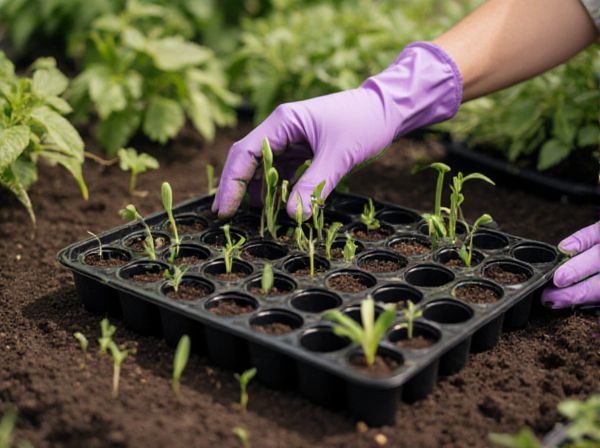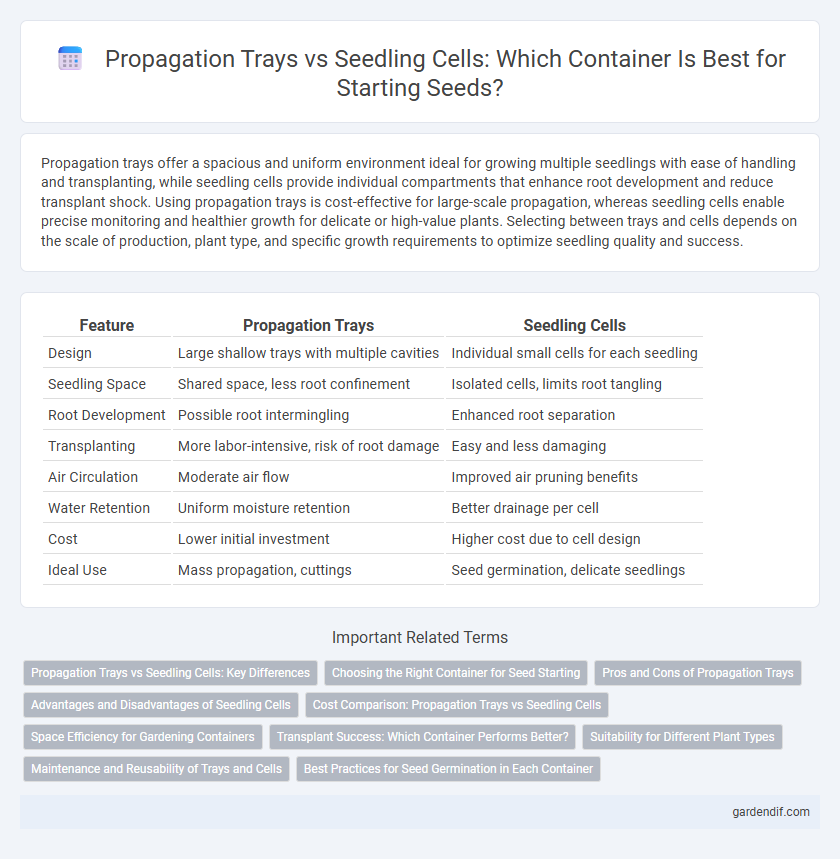
Propagation trays vs seedling cells Illustration
Propagation trays offer a spacious and uniform environment ideal for growing multiple seedlings with ease of handling and transplanting, while seedling cells provide individual compartments that enhance root development and reduce transplant shock. Using propagation trays is cost-effective for large-scale propagation, whereas seedling cells enable precise monitoring and healthier growth for delicate or high-value plants. Selecting between trays and cells depends on the scale of production, plant type, and specific growth requirements to optimize seedling quality and success.
Table of Comparison
| Feature | Propagation Trays | Seedling Cells |
|---|---|---|
| Design | Large shallow trays with multiple cavities | Individual small cells for each seedling |
| Seedling Space | Shared space, less root confinement | Isolated cells, limits root tangling |
| Root Development | Possible root intermingling | Enhanced root separation |
| Transplanting | More labor-intensive, risk of root damage | Easy and less damaging |
| Air Circulation | Moderate air flow | Improved air pruning benefits |
| Water Retention | Uniform moisture retention | Better drainage per cell |
| Cost | Lower initial investment | Higher cost due to cell design |
| Ideal Use | Mass propagation, cuttings | Seed germination, delicate seedlings |
Propagation Trays vs Seedling Cells: Key Differences
Propagation trays offer uniform spacing and enhanced root aeration compared to seedling cells, promoting healthier initial growth. Seedling cells provide individual compartments that reduce root disturbance during transplanting, aiding in better seedling establishment. The choice between propagation trays and seedling cells depends on factors like species, transplanting methods, and desired root development characteristics.
Choosing the Right Container for Seed Starting
Propagation trays offer uniform drainage and airflow, ideal for maintaining consistent moisture levels essential for seed germination. Seedling cells provide individual compartments that reduce root disturbance and encourage strong early root development. Selecting the right container depends on the plant species and growing conditions, with seedling cells favored for transplanting ease and propagation trays suited for high-volume seed starting.
Pros and Cons of Propagation Trays
Propagation trays offer uniform spacing and easy handling, promoting consistent root development and efficient space utilization in nurseries. However, they can limit individual root expansion and increase susceptibility to root circling compared to seedling cells. Their cost-effectiveness and reusability make them ideal for large-scale propagation, though seedling cells provide better aeration and drainage for delicate seedlings.
Advantages and Disadvantages of Seedling Cells
Seedling cells offer precise root development and easier transplanting due to their rigid structure and uniform size, which minimizes root disturbance and transplant shock. Their main disadvantage is higher cost and limited space compared to propagation trays, which are more economical and allow for larger volume propagation but can cause more root entanglement. Seedling cells also enhance airflow and drainage, reducing the risk of damping-off disease, but require more labor in handling and monitoring individual seedlings.
Cost Comparison: Propagation Trays vs Seedling Cells
Propagation trays generally offer a lower initial cost compared to seedling cells due to their simple design and reusable material, making them cost-effective for large-scale propagation. Seedling cells, while more expensive upfront due to individual cell structures and higher-quality plastics, often reduce labor costs and transplant shock, potentially increasing overall plant yield and profitability. Evaluating the total cost of ownership, including replacement frequency, labor, and plant survival rates, is essential for accurate cost comparison between propagation trays and seedling cells.
Space Efficiency for Gardening Containers
Propagation trays maximize space efficiency by enabling dense seed placement with uniform cell sizes ideal for small seedlings. Seedling cells, while offering individual root zones for healthier growth, often require more surface area for the same number of plants. Choosing propagation trays optimizes limited gardening container space, supporting higher plant volumes in compact areas.
Transplant Success: Which Container Performs Better?
Propagation trays typically offer higher transplant success rates due to their uniform cell size and shallow depth, which encourages strong root development and ease of handling during transplantation. Seedling cells, while providing more space for individual root expansion, can cause increased root disturbance and transplant shock when removed, potentially reducing success rates. Studies indicate that propagation trays promote more consistent root systems and better acclimatization, resulting in improved post-transplant vigor and survival.
Suitability for Different Plant Types
Propagation trays provide an ideal environment for fast-growing, small-seeded plants such as herbs and leafy greens due to their shallow depth and uniform cell size. Seedling cells offer deeper root zones, making them suitable for larger, slow-developing plants like tomatoes, peppers, and flowers that require extended root development before transplanting. Selecting propagation trays or seedling cells depends on plant species' root growth patterns and transplanting timelines to optimize seedling health and establishment.
Maintenance and Reusability of Trays and Cells
Propagation trays are typically made of durable plastic that withstands repeated sterilization and cleaning, making them highly reusable with proper maintenance routines such as regular washing and disinfecting to prevent disease transmission. Seedling cells, often composed of thinner plastic or biodegradable materials, may degrade faster and require more frequent replacement due to sensitivity to cleaning chemicals and physical wear. The more robust design of propagation trays offers superior longevity and cost-effectiveness for large-scale planting operations compared to the limited lifespan and maintenance challenges of seedling cells.
Best Practices for Seed Germination in Each Container
Propagation trays provide uniform moisture retention and consistent temperature control, ideal for starting large quantities of seeds with high germination rates. Seedling cells offer individual root space that reduces transplant shock and encourages stronger root development, best suited for plants requiring delicate handling. Best practices include using a sterile, well-draining medium in trays, while seedling cells benefit from targeted watering and more frequent monitoring to prevent damping-off.
Propagation trays vs seedling cells Infographic

 gardendif.com
gardendif.com